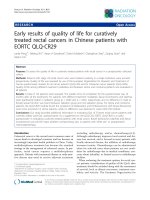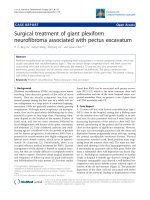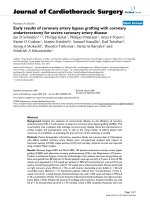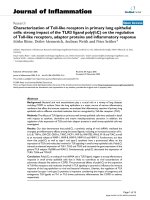Báo cáo y học: "Early results of coronary artery bypass grafting with coronary endarterectomy for severe coronary artery disease" ppsx
Bạn đang xem bản rút gọn của tài liệu. Xem và tải ngay bản đầy đủ của tài liệu tại đây (235.51 KB, 7 trang )
BioMed Central
Page 1 of 7
(page number not for citation purposes)
Journal of Cardiothoracic Surgery
Open Access
Research article
Early results of coronary artery bypass grafting with coronary
endarterectomy for severe coronary artery disease
Jan D Schmitto*
1,3
, Philipp Kolat
1
, Philipp Ortmann
1
, Aron F Popov
1
,
Kasim O Coskun
1
, Martin Friedrich
1
, Samuel Sossalla
2
, Karl Toischer
2
,
Suyog A Mokashi
3
, Theodor Tirilomis
1
, Mersa M Baryalei
1
and
Friedrich A Schoendube
1
Address:
1
Department of Thoracic-, Cardiac- and Vascular Surgery, Georg August University of Goettingen, Germany,
2
Department of Cardiology
and Pneumology, Georg August University of Goettingen, Germany and
3
Department of Cardiac Surgery, Brigham and Women's Hospital,
Harvard Medical School, Boston, MA, USA
Email: Jan D Schmitto* - ; Philipp Kolat - ; Philipp Ortmann - ;
Aron F Popov - ; Kasim O Coskun - ; Martin Friedrich -
goettingen.de; Samuel Sossalla - ; Karl Toischer - ;
Suyog A Mokashi - ; Theodor Tirilomis - ;
Mersa M Baryalei - ; Friedrich A Schoendube -
* Corresponding author
Abstract
Background: Despite the existence of controversial debates on the efficiency of coronary
endarterectomy (CE), it is still used as an adjunct to coronary artery bypass grafting (CABG). This
is particularly true in patients with endstage coronary artery disease. Given the improvements in
cardiac surgery and postoperative care, as well as the rising number of elderly patient with
numerous co-morbidities, re-evaluating the pros and cons of this technique is needed.
Methods: Patient demographic information, operative details and outcome data of 104 patients
with diffuse calcified coronary artery disease were retrospectively analyzed with respect to
functional capacity (NYHA), angina pectoris (CCS) and mortality. Actuarial survival was reported
using a Kaplan-Meyer analysis.
Results: Between August 2001 and March 2005, 104 patients underwent coronary artery bypass
grafting (CABG) with adjunctive coronary endarterectomy (CE) in the Department of Thoracic-,
Cardiac- and Vascular Surgery, University of Goettingen. Four patients were lost during follow-up.
Data were gained from 88 male and 12 female patients; mean age was 65.5 ± 9 years. A total of 396
vessels were bypassed (4 ± 0.9 vessels per patient). In 98% left internal thoracic artery (LITA) was
used as arterial bypass graft and a total of 114 vessels were endarterectomized. CE was performed
on right coronary artery (RCA) (n = 55), on left anterior descending artery (LAD) (n = 52) and
circumflex artery (RCX) (n = 7). Ninety-five patients suffered from 3-vessel-disease, 3 from 2-
vessel- and 2 from 1-vessel-disease. Closed technique was used in 18%, open technique in 79% and
in 3% a combination of both. The most frequent endarterectomized localization was right coronary
artery (RCA = 55%). Despite the severity of endstage atherosclerosis, hospital mortality was only
5% (n = 5). During follow-up (24.5 ± 13.4 months), which is 96% complete (4 patients were lost
Published: 22 September 2009
Journal of Cardiothoracic Surgery 2009, 4:52 doi:10.1186/1749-8090-4-52
Received: 29 June 2009
Accepted: 22 September 2009
This article is available from: />© 2009 Schmitto et al; licensee BioMed Central Ltd.
This is an Open Access article distributed under the terms of the Creative Commons Attribution License ( />),
which permits unrestricted use, distribution, and reproduction in any medium, provided the original work is properly cited.
Journal of Cardiothoracic Surgery 2009, 4:52 />Page 2 of 7
(page number not for citation purposes)
caused by unknown address) 8 patients died (cardiac failure: 3; stroke: 1; cancer: 1; unknown
reasons: 3). NYHA-classification significantly improved after CABG with CE from 2.2 ± 0.9
preoperative to 1.7 ± 0.9 postoperative. CCS also changed from 2.4 ± 1.0 to 1.5 ± 0.8
Conclusion: Early results of coronary endarterectomy are acceptable with respect to mortality,
NYHA & CCS. This technique offers a valuable surgical option for patients with endstage coronary
artery disease in whom complete revascularization otherwise can not be obtained. Careful patient
selection will be necessary to assure the long-term benefit of this procedure.
Introduction
Fifty years ago, Bailey [1] was the first to describe coronary
endarterectomy in man without cardiopulmonary bypass
or associated coronary artery bypass grafting. Although no
definitive conclusions could be drawn from his pioneer-
ing work, it was presented with the intent of encouraging
further research in this unknown section. In the early
years after this report, several institutions lead by Hallèn
[2], Effler [3], Dilley [4] and many others shared his vision
of long-term patency after revascularization and per-
formed that procedure as an adjunct to CABG. The benefit
was relief from angina in the majority of these cases; but
the price to pay was higher incidence of postoperative
mortality and morbidity. This fact has been the basis for
several controversial debates [5,6]; proponents regarded
this technique to be the last opportunity for patients with
endstage atherosclerosis. Others have criticized the
increased intra- and post-operative risks while question-
ing the long-term benefits [5]. Therefore, this add-on was
only given status of second importance, limited for
patients with high-grade atherosclerosis.
Methods
One-hundred and four patients with diffuse coronary
artery disease underwent coronary artery bypass grafting
(CABG) with adjunctive coronary endarterectomy (CE) of
at least one artery in the Department of Thoracic-, Car-
diac- and Vascular Surgery, Goettingen. Data were ana-
lyzed with respect to mortality, functional capacity
(NYHA) and angina pectoris (CCS). Information concern-
ing the patients' preoperative status were extracted from
an extensive clinical database. Postoperative data were
obtained from our clinical database, as well as by tele-
phone survey, postal questionnaire and physical examina-
tion. Actuarial survival was reported using Kaplan-Meyer
analysis. Two different surgical techniques, the open and
the closed coronary endarterectomy (CE) were used in
this study. Both techniques involve making an incision in
the coronary vessel to extract the atherosclerotic lesion.
We defined the closed technique as creating an incision
no longer than 2 cm proximal to the target for removing
the plaque. Whereas, in the open technique an incision
the length of the lesion is made to directly remove it. After
surgery systemic heparinization was started early postop-
eratively to avoid thrombembolic complications or early
occlusions of the coronaries. That means, if the postoper-
ative bleeding rate was lower than 50 ml/hour we started
with the heparine infusion already 4 hours postopera-
tively. 100 mg of aspirin were given daily, starting at the
first postoperative day.
Results
Details from this heterogeneous cohort are summarized
in Table 1. Between August 2001 and March 2005, 104
Table 1: Preoperative patients characteristics
All
Patients (n) 100
Age (y)
Mean 65.5 ± 9.23
Range 35-83
Cardiac Risk Factors
BMI (Mean) 28.33 ± 4.03
Hypertension 94
Diabetic mellitus 35
Hypercholesterolemia 80
(Ex-)Smoker 54
Family History 55
Angina-Class
CCS I 20
CCS II 32
CCS III 31
CCS IV 15
Unknown 2
Dyspnea
NYHA I 26
NYHA II 36
NYHA III 26
NYHA IV 10
Unknown 2
Previous Stroke 13
Previous Myocardial Infarction 50
Previous PTCA 14
Operative Priority
Elective 2
Urgent 19
Emergency 50
Unknown 29
Diseased vessels
x1 2
x2 3
x3 95
Journal of Cardiothoracic Surgery 2009, 4:52 />Page 3 of 7
(page number not for citation purposes)
patients underwent coronary artery bypass grafting
(CABG) with adjunctive coronary endarterectomy (CE) in
the Department of Thoracic-, Cardiac- and Vascular Sur-
gery, University of Goettingen, Germany. Follow-up of
100 patients was complete: 88 patients were male, 12
were female, mean age was 65.5 +/- 9 years. Preoperative
body mass index (BMI) was 28.33 ± 4.03 kg/m
2
, hyper-
tension was present in 94%, 35 patients suffered from dia-
betes, 80% showed hypercholesterolemia, 54% were
smokers and, finally, 55% had positive family history
concerning the cardiovascular system.
Each patient could be associated with more than 3 cardiac
risk factors (mean: 3.2 ± 1.1); patients with 2 or less risk
factors represented the minority, as shown in Figure 1.
Ninety-five patients suffered from 3-vessel-disease, 3
patients from 2-vessel- and 2 patients from 1-vessel-dis-
ease. Referring to the Canadian Cardiovascular Society
(CCS), 20% were preoperatively considered to belong to
CCS I, 32% in II, 31% in III and 15% in IV. The cohort was
also distributed referring to New York Heart Association
criteria (NYHA): 26% were NYHA I, 36% NYHA II, 26%
belong to NYHA III and 10% to NYHA IV.
To underline severity of atherosclerosis, previous events
like stroke (13%), myocardial infarction (50%) and prior
PTCA (14%) were also considered. Forty percent of the
cases were given an operative priority of an emergency
procedure. Detailed information concerning the distribu-
tion of gender among cardiac risk factors is shown in
Table 1. Three-hundred and ninety-six vessels were
bypassed (4 ± 0.9 vessels per patient). In 98% of cases, the
left internal thoracic artery (LITA) was used as arterial
bypass graft and a total of 114 vessels were endarterect-
omized. CE was performed on right coronary artery (RCA)
(n = 55), on left anterior descending artery (LAD) (n = 52)
and circumflex artery (RCX) (n = 7).
Closed technique was used in 18%, open technique in
79% and in 3% a combination of both. Cardiopulmonary
bypass time was 192 ± 56 minutes, aortic cross clamp time
was 119 ± 32 minutes. Three myocardial infarctions
occured during operation time, defined by ST-elevations
in electrocardiography and postoperative CK-(> 270 U/l)/
CKMB-(>17 U/l) levels (Table 2). Duration of intensive
care unit (ICU) stay was 5.6 ± 8.4 days. Ventilation was
obtained for 52.9 ± 100.8 hours for the whole cohort. Iso-
lating the smokers group, artificial respiration time was
61.7 ± 125.5 hours; non-smokers had to be supported for
41.7 ± 54.1 hours, more than 48% less.
Infection rate (as defined by leucocytosis, temperature
>38°C and C-reactive protein >8 mg/l) on ICU was 18%,
main complications were bronchopulmonary (n = 18),
sternal infection (n = 3) and sepsis (n = 2). Multiple
Distribution of risk factorsFigure 1
Distribution of risk factors.
0
5
10
15
20
25
30
35
0x 1x 2x 3x 4x 5x
risk factors (RF)
No. of Patients (%)
Journal of Cardiothoracic Surgery 2009, 4:52 />Page 4 of 7
(page number not for citation purposes)
matches per patient were possible. Despite severity of end-
stage atherosclerosis hospital mortality was only 5% (n =
5). During follow-up (24.5 ± 13.4 months), which is 96%
complete (4 patients were lost caused by unknown
address), 8 patients died (cardiac failure: 3; stroke: 1; can-
cer: 1; unknown reasons: 3). All deaths, except one, were
male patients. Mean follow-up-time, this study is based
on, was 24.5 ± 13.4 months after surgery.
Patients were discharged from hospital after 15.9 ± 13.9
days. Survival rates for all patients are presented in Kap-
lan-Meyer curve in Figure 2. NYHA-classification clearly
improved after CABG with CE from 2.2 ± 0.9 preoperative
to 1.7 ± 0.9 postoperative. 48 patients were postopera-
tively regarded to belong to NYHA I, 30 to NYHA II, 4 to
NYHA III and finally, 8 to NYHA IV. Preoperative distribu-
tion was 26% for NYHA I, 36% NYHA II, 26% belong to
NYHA III and 10% to NYHA IV. CCS also changed from
2.4 ± 1.0 to 1.5 ± 0.8. 58 patients were regarded to belong
to CCS I, 21 to CCS II, 6 to CCS III and 3 to CCS IV. Pre-
operatively, 20% were considered to belong to CCS I, 32%
in II, 31% in III and 15% in IV.
Discussion
Coronary artery bypass grafting is a worldwide routine
cardiac surgery procedure to revascularize ischemic myo-
cardium of patients with severe coronary artery disease.
The operation was performed over 51,000 times in Ger-
many in the year 2006 [7]. Due to demographic develop-
ment, an increasing number of elderly and patients with
multiple co-morbidities, improvements in cardiology
diagnostics, medications and invasive interventions
(PTCA or stenting), cardiac surgeons often are confronted
with geriatric patients suffering from diffusely and
severely calcified coronary artery disease. While the total
number of operative interventions has decreased, the
complexity and severity of each procedure has increased.
In addition, elderly patients with diffusely calcified multi-
vessel atherosclerosis, especially of the smaller branches,
are not amenable to stenting and angioplasty - cardiologic
methods are limited. Therefore, it is important to offer a
valuable alternative to these patient that begins at the
point where the possibilities of conservative medicine
end.
Since Bailey's first coronary endarterectomy in the late
50's [1], the circumstances under which cardiac opera-
tions are performed have since changed, including: the
use of cardiopulmonary bypass, increased technical and
pharmaceutical improvements and last but not least, the
growing experience of cardiac surgeons led to a point, in
which procedures like these can be performed more safely
and can almost be considered to be routine, just like
CABG itself. Today's conditions are not comparable with
those of starter-time, in which controversial debates on
efficiency of coronary endarterectomy (CE) were held.
Higher rates of morbidity and mortality were the frequent
points of criticism and forced CE to play a role of second
importance [5,6]. Therefore, it is important to focus on
current results, to rethink of this alternative and to reeval-
uate the indication for this surgical technique [5,6].
In our department, coronary endarterectomy combined
with CABG was performed in 104 cases in about four
years. Indication for CE was handled restrictively. It was
only performed on occluded, nearly occluded and/or cal-
cified vessels with long-range stenoses, if regular anasto-
mosis between graft and coronary artery seemed to be
technically impossible. Decision to perform endarterecto-
mies was therefore made intraoperatively, based on local
findings on these patients with severe calcified atheroscle-
rosis. The operations were performed by fully-trained staff
cardiac surgeons. Although a surgical trainee participated
in the operations, the critical portions were performed by
experienced surgeons.
This severity of atherosclerosis that affects the coronary
arteries and its fatal consequences may be demonstrated
through following findings: in the majority of the cases,
an event like stroke or myocardial infarction occurred
before intervention. According to NYHA and CCS it is
understandable that these patients were hardly able to
handle daily life activities. This was not only revealed by
the NYHA-/CCS-constellation or preoperative symptoms
like vertigo, edema or syncopes but also by interviews and
postal questionnaires. In 40% of the cases, CABG and CE
were performed as an emergency procedure -one more
clue for the progressed severity of this disease.
Table 2: Operative data
Number of Grafts
x1 1
x2 5
x3 19
x4 46
x5 24
x6 4
Unknown 1
Mean 4 ± 0.95
Number of CE
RCA 55
LAD 35
Cx 7
DB 17
Cross Clamp Time (min) 119 ± 31.6
Cardiopulm. Bypass Time (min) 192 ± 56.5
Journal of Cardiothoracic Surgery 2009, 4:52 />Page 5 of 7
(page number not for citation purposes)
Our results also indicate an expected match among this
heterogeneous group of patients: nearly all of them,
except one woman, show a variegated mixture of cardiac
risk factors (Figure 1), averaging more than three factors
per patient.
Even today, in the era of wide spread information con-
cerning health-prevention via different media, these dis-
ease-supporting avoidable factors are still present and
imply a major difficulty in coping with the disease.
Operation time and therefore cardiopulmonary bypass- as
well as aortic cross clamp time were longer comparing
with other studies. This can be explained by several fac-
tors:
1. Operation technique: in most cases open technique was
used based on surgeons' preferences. It offers free insight
to local findings, exposing the whole arterial lumen and
side branches containing atherosclerotic occlusive mate-
rial and therefore guarantees the quality (which means
avoiding an intima flap and therefore assure the same
plane etc.) of the endarterectomy by avoiding residuals.
On the other hand it takes more time to fulfil the long-
range suture of the vessel.
2. Severity of atherosclerosis: many vessels are deeply
affected in this cohort. The majority suffered from three-
vessel-disease, resulting in almost four bypass-grafts per
patient.
3. Localization: a huge amount of vessels that were
bypassed or/and endarterectomized belonged to right cor-
onary artery system, which is probably technically the
most challenging localization. Preparation as well as
suturing on the back side of heart is time-consuming.
4. High rate of calcification: CE was only performed, when
regular anastomosis seemed to be impossible. It was
meant to be the last possibility to revascularize ischemic
myocard. The high number of CE's performed underlines
the fact of endstage coronary artery disease among our
patients.
5. LITA was used in 98%: LITA is still the most important
graft that can be used in order to guarantee long-term-pat-
ency caused by better vasomotor function concerning the
flow-rate [5-8]. In case of bypassing more than one vessel,
which was the common case, veins like vena saphena
magna or parva were used, as usually.
The duration of time spent in the ICU is greater in our
study as compared to other studies [8-10], but this is
Kaplan-Meyer-Survival-CurveFigure 2
Kaplan-Meyer-Survival-Curve.
Survival Time
Complete Censored
0 10203040
Months
0,5
0,6
0,7
0,8
0,9
1,0
Cumulative Proportion Surviving
Journal of Cardiothoracic Surgery 2009, 4:52 />Page 6 of 7
(page number not for citation purposes)
based on the fact that an intermediate-care unit was inter-
posed in our hospital. Patients from the ICU were directly
sent directly to the ward floor, once their general health
status was deemed appropriate. According to the fact that
our patients suffered from severe endstage atherosclerosis
as well as from other typical geriatric morbidities, it is not
surprising that the length of stay is prolonged.
Hospital-mortality-rate, as presented in our study, is
acceptable compared to other studies which range from
2.0 - 6.5% [5,6,8,11-16], considering the preoperative
health state of the patients. It is remarkable that every
death, with the exception of one, involved males. Follow-
ing revascularization by CABG and adjunctive CE, the
patients' subjective state of health significantly improved.
No reports exist addressing the issue of ventilation time
on CE in the ICU. In our study, we have interestingly
shown that the span between smokers and non-smokers
is remarkable. Non-smokers required 48% less time with
ventilator assistance compared to the former with a posi-
tive nicotine history. This corresponds to a lower risk for
tracheal irritation and broncho-pulmonary infection.
Similar results for CE patients are not described in litera-
ture so far. Further research on this topic seems to be nec-
essary.
Despite the controversy surrounding the efficiency of cor-
onary endarterectomy (CE) [5,6,17-20], it is still used as
an adjunctive treatment to coronary artery bypass grafting
(CABG) for patients with highly calcified, end-staged cor-
onary artery disease.
Conclusion
This study demonstrates that results of coronary endarter-
ectomy are acceptable with respect to mortality, NYHA
and CCS. CABG and adjunctive CE offers a valuable surgi-
cal option for patients with endstage coronary artery dis-
ease in whom complete revascularization otherwise could
not be obtained. It is important to note, however, that this
technique should not be considered a substitute for
CABG. Not every patient undergoing bypass is suitable for
this procedure. The procedure should be performed by
highly experienced surgeons. Nevertheless, the reporting
of additional experience and follow-up data will be neces-
sary to assure long-term benefits.
Competing interests
The authors declare that they have no competing interests.
Authors' contributions
JDS conceived of the study, and participated in its design
and coordination. PK conceived of the study, and partici-
pated in its design and coordination. PO participated in
the design of the study and performed the statistical anal-
ysis. AFP conceived of the study, and participated in its
design and coordination. KOC participated in the design
of the study and performed the statistical analysis. MF par-
ticipated in the design of the study and performed the sta-
tistical analysis. SS conceived of the study, and
participated in its design and coordination. SAM partici-
pated in the design of the study and performed the statis-
tical analysis. TT participated in the design of the study
and performed the statistical analysis. MMB participated
in the design of the study and performed the statistical
analysis. FAS conceived of the study, and participated in
its design and coordination. All authors read and
approved the final manuscript.
References
1. Bailey CP, May A, Lemmon WM: Survival after coronary endar-
terectomy in man. JAMA 1957, 164:641.
2. Hallén A, Bjoerk L, Bjoerk VO: Coronary Thromboendarterec-
tomy. J Thoracic and Cardiovasc Surg 1963, 45:216.
3. Effler DB, Groves LK, Sones FM jr, Shirey EK: Endarterectomy in
the treatment of coronary artery disease. J Thoracic and Cardi-
ovasc Surg 1964, 47:98.
4. Dilley RB, Cannon JA, Kattus AA: The treatment of coronary
occlusive disease by endarterectomy. J Thoracic and Cardiovasc
Surg 1965, 50:4.
5. Tiruvoipati R, Loubani M, Lencioni M, Ghosh S, Jones PW, Patel RL:
Coronary endarterectomy: impact on morbidity and mor-
tality when combined with coronary artery bypass surgery.
Ann Thorac Surg 2005, 79(6):1999-2003.
6. Ferraris VA, Harrah JD, Moritz DM, Striz M, Striz D, Ferraris SP:
Long-term angiographic results of coronary endarterec-
tomy. Ann Thorac Surg 2000, 69(6):1737-43.
7. Gummert JF, Funkat A, Beckmann A, Schiller W, Hekmat K, Ernst M,
Krian A: Cardiac Surgery in Germany during 2006. Thoracic
Cardiovasc Surg 2007, 55(6):343-50.
8. Shapira OM, Akopian G, Hussain A: Improved Clinical Outcomes
in Patients Undergoing Coronary Artery Bypass Grafting
With Coronary Endarterectomy. Ann Thoracic Surg 1999,
68:2273-8.
9. Claus T, Just S, Schubel B: Koronare Endarteriektomie -Retro-
spektive Verlaufsbeobachtung unter Betrachtung der post-
operativen Antikoagulation. Zeitung f. Herz-, Thorax-,
Gefäßchirurgie 1996, 10:242-252.
10. Eryilmaz S, Inan MB, Eren NT: Coronary endarterectomy with
off-pump coronary artery bypass surgery. Ann Thoracic Surg
2003, 75:865-9.
11. Christenson JT, Simonet F, Schmuziger M: Extensive endarterec-
tomy of the left anterior descending coronary artery com-
bined with coronary artery bypass grafting. Coronary Artery
Disease 1995, 6:
731-737.
12. Gill IS, Beanlands DS, Boyd WD: Left Anterior Descending
Endarterectomy and Internal Thoracic Artery Bypass for
Diffuse Coronary Disease. Ann Thoracic Surg 1998, 65:659-62.
13. Ferraris VA, Harrah JD, Moritz DM: Long-Term Angiographic
Results of Coronary Endarterectomy. Ann Thoracic Surg 2000,
9:1737-43.
14. Asimakopoulos G, Taylor KM, Ratnatunga CP: Outcome of Coro-
nary Endarterectomy: A Case-Control Study. Ann Thoracic
Surg 1999, 67:989-93.
15. Marinelli G, Chiappini B, Eusanio Di M: Bypass grafting with coro-
nary endarterectomy: Immediate and long-term results.
Journal of Thoracic and Cardiovasc Surg 2002, 124:3.
16. Byrne JG, Karavas AN, Gudbjartson T: Left anterior descending
coronary endarterectomy: Early and late results in 196 con-
secutive patients. Ann Thoracic Surg 2004, 78:867-74.
17. Djalilian AR, Shumway SJ: Adjunctive coronary endarterectomy:
Improved safety in modern cardiac surgery. Ann Thoracic Surg
1995, 60:1749-54.
18. Tasdemir O, Kiziltepe U, Karagöz HY: Long-term results of
reconstructions of the left anterior descending coronary
Publish with BioMed Central and every
scientist can read your work free of charge
"BioMed Central will be the most significant development for
disseminating the results of biomedical research in our lifetime."
Sir Paul Nurse, Cancer Research UK
Your research papers will be:
available free of charge to the entire biomedical community
peer reviewed and published immediately upon acceptance
cited in PubMed and archived on PubMed Central
yours — you keep the copyright
Submit your manuscript here:
/>BioMedcentral
Journal of Cardiothoracic Surgery 2009, 4:52 />Page 7 of 7
(page number not for citation purposes)
artery in diffuse atherosclerotic lesions. J Thorac Cardiovasc Surg
1996, 112:745-54.
19. Sundt TM III, Camillo CJ, Mendeloff EN: Reappraisal of coronary
endarterectomy for the treatment of diffuse coronary artery
disease. Ann Thoracic Surg 1999, 68:1272-7.
20. Nishi H, Miyamoto S, Takanashi S: Optimal method of coronary
endarterectomy for diffusely diseased coronary arteries. Ann
Thoracic Surg 2005, 79:846-53.









